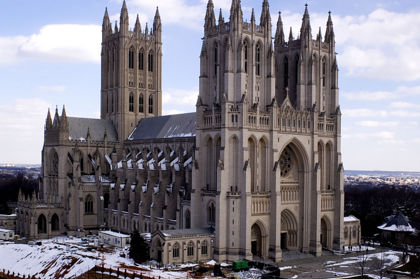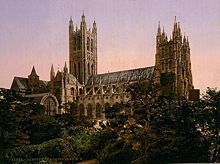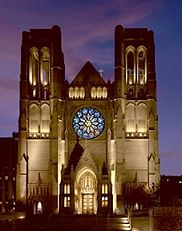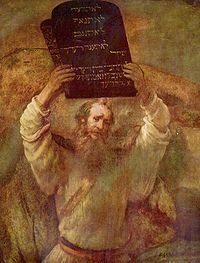Church
 From Conservapedia
From Conservapedia 
| |
| Christianity | |
|
Foundations Bible Christian Theology History and Traditions Important Figures | |

The term church, over time, has been used to describe all of the following:
- All Christians who have ever lived, live currently, or will live in the future, regardless of personal denominational affiliation, membership or attendance (sometimes referred to as the "universal Church" or the "invisible Church")
- A group of believers organized in an individual congregation (e.g. the believers comprising the membership and regular attenders of Prestonwood Baptist Church), regardless of any denominational affiliation or lack thereof
- A group of congregations organized in a denomination (e.g. the Roman Catholic Church or the Southern Baptist Convention)
- It is also used in reference to a building in which Christian worship takes place.
A church that contains the seat of a bishop is designated a cathedral.[1]
The word "Church" arises in Christian use from a number of New Testament sources, perhaps the prime one being the words of Jesus - "On this rock I will build my Church". This is at once concrete and it is general with portents of the future.
It is concrete, as the Greek term for the "Church", the "Ekklesia", those that are "called out" (of the environs) for the purpose of gathering together, is a direct reference to the synagogue ("led or assembled togther") - "Beit Knesset" in Hebrew, those that are "gathered together", visible, concrete, societal, a people. These, then, together are the Israel of God, a new creation, upon which will sit, guide, judge, the 12 apostles, waiting for the Lord to return.
And yet, the meaning of Church is something beyond this: it is general, something that takes it in but transcends this, as Church is somehow related to the Body of the Risen Christ which He now in Heaven fills and lives in here on earth. We the Church have now somehow by His grace become part of His Body, or we, all together, are His Body on earth, through which He lives and continues His good and continuing work of the Kingdom of God.[2]
Our nexus to His Body are the following: it is faith in Him our Savior that has initially brought us and our families to the Body to join us togther with a real community and to Him. It is baptism which has brought us firmly into the life of the Spirit of the Body and Community and signifying that it is to Him that we belong. It is the communion with Him granted us at the table of the Lord in "Communion" that strengthens us for our life here on earth. It is the illumination and actual grace to help that comes to us in the hearing of His Word of Holy Scripture. It is in confirmation of our commitment to Him in obeying that Word which we have heard that these weak and mortal bodies on earth receive Heaven's transforming power and new life - even as we live on earth awaiting His return; and it is in forgiving love, one member of the Body to another, that we actually experience the sweetness of Jesus living with us in His Body on earth, the Church.
The Church is thus concrete and specific, the people of God among many peoples, and transcending this, it is general, universal (Latin, "catholic"), attached to a greater reality - the Risen Christ Himself. The joining of Christ in Heaven with His Body on Earth, the Church gives force to this saying of the Lord:
"Then shall the King say unto them at his right hand, Come, ye blessed of my Father, inherit the kingdom prepared for you from the foundation of the world; for I was an hungred, and ye gave me meat: I was thirsty, and ye gave me drink: I was a stranger, and ye took me in:Naked, and ye clothed me: Sick. and visited me: Then shall the righteous answer him, saying, Lord ,when saw we thee an hungred and fed thee? or thirsty, and gave thee drink? When saw we thee a stranger and took thee in? or naked and clothed thee? or when saw we thee sick or in or in prison, and came unto thee? And the King shall answer, and say unto them, inasmuch as ye have done it unto one of the least of these, my brethren, ye have done it unto me." Matthew 25:35-40 (KJV).
Contents
- 1 Possibly the first Church Structure
- 2 Etymology
- 3 Church and the internet
- 4 Famous cathedrals
- 5 Churches in India
- 6 Street churches and storefront churches
- 7 References
- 8 See also
Possibly the first Church Structure[edit]
On Mount Zion in Jerusalem, and entering the room below that of the Last Supper of Jesus, identified wrongly as such by the Crusaders, close to the present day Roman Catholic Dormition Abbey, one views the huge remembrance stone indicating the tomb of King David from Crusader times. Outside the tomb enclosure, there are usually Orthodox Jews praying. But behind the remembrance stone on the wall of the room facing the Temple Mount, one can see the niche at the exact height above the ground for the scrolls of the Bible to be placed. This indicates that the room had originally been a synagogue. Walking around the outside of the room in the courtyard, one can see the "Herodian" stone blocks with their characteristic and tell-tale incised borders. So this room was originally built in the first century. Further, the stones were of different sizes and shapes indicating that this was their secondary placement having been brought here from elsewhere, perhaps the destroyed temple area itself. During the 1948 Israeli War of Independence, an artillery shell landed in the courtyard, shattering the successive layers of plaster of the room within, until the last layer could be seen, extending down past the Ottoman Turk, Early Muslim, Crusader, Byzantine period floor levels, ending at the original 1st century floor. This was further confirmation that the room was built in the first century. There were prayers in Greek to Jesus inscribed on the wall. This indicates that the synagogue was a Hellenistic-oriented Jewish Christian synagogue (similar to the New Testament reference of the Jewish "synagogue of the Libertines", Acts 6:9). It also explains why the room, right across the valley from the Temple Mount, was not oriented to it in the usual way so that the worshipers would face the temple, but was rather facing north in the exact direction of both the later "Constantinian" Church of the Holy Sepulcher and the most recent "Gordon's Calvary" - the two contenders for the site of the crucifixion, burial and resurrection of Jesus.
This "Kibla" or "prayer direction" is in accord with an ancient practice of facing the direction of importance. For the Old Testament and Judaism, the kibla was facing Jerusalem, and, in particular if within the city of Jerusalem, this meant facing the temple. For Islam (after it disavowed Jerusalem as the kibla), it meant facing Mecca. And, at one time, for Christians, it meant facing the East, the direction of the rising sun[3] and also the direction from which Christ would return. Almost all Catholic and Orthodox churches from ancient times to this day are built so that the congregation faces east toward the altar.[4]
The mosaic Byzantine Madaba map of Jerusalem shows the location and the room as being adjacent to another structure - the Church of the Holy Apostles, indicating that it was considered as particularly important or held holy in the Byzantine period. The later huge Crusader period Church of St. Mary, built at the same spot as the earlier Byzantine church, is shown by archeology to have actually included the room within the Church structure. This, then, was most likely the first Church and home to believers in Jesus before the destruction of Jerusalem in A.D. 70, the same "Church House", possibly the home of Mark, that would later be called "The Church of the Holy Apostles" and the "Mother of all Churches"[5] around which the Church of St. Mary was erected.
Etymology[edit]
The word church comes, through the Old English circe, kirk, from the Koine Greek κυριακον (kyriakon), which means "Lord's House".
Church and the internet[edit]
As late as 2020, a multitude of churches were still not ready to arrange internet substitutes to large congregations.[6]
Famous cathedrals[edit]
See also: Famous cathedrals
Famous Cathedrals
Cathedrals have been for centuries humanity's expression of God's love.

Notre Dame de Paris

St. Peter's Basilica

Cathedrale de Brasilia

Catedral de Rio de Janeiro
Burgos Cathedral

Cathedral of Milan (Duomo)

St. Basils Cathedral

Cathedral of Christ the Savior

Cathedral of Murcia

Duomo Santa Maria di Fiore

Cathedral of Pisa and Tower

Ulm Cathedral

Lincoln Cathedral
|
|
|
|
_Germany.jpg)
Cathedral of Cologne

Cathedral of Santiago de Compostela

Liverpool Anglican Cathedral

St. Patrick's Cathedral
Cathedral of the Plains, Kansas

Catedral de Valencia

Washington National Cathedral
Churches in which a bishop presides all over the world.
Churches in India[edit]


Street churches and storefront churches[edit]
Many churches are small churches that focus on the spiritual and social concerns of a particular neighborhood. Storefront churches often provide assistance to local residents.

According the New Zealand census, from 2013 to 2018, the number of "Evangelical, Born Again and Fundamentalist Christians" grew from 15,381 individuals to 38,127 individuals from 2013 to 2018.[7] See: Growth of evangelical Christianity in New Zealand

According to the atheist Sikivu Hutchinson, atheist organizations generally focus on church/state separation and creationism issues and not the concerns the less affluent African-American population faces.[8] See also: Atheism and charity
References[edit]
- ↑ Cathedral (dictionary.reference.com)
- ↑ Preterism teaches that the Church is the fulfillment of the Second Coming of Christ who now reigns eternally through the Church as His Body on earth.
- ↑ Malachi 4 in Protestant Bibles (e.g. KJV) Malachi 3 in Catholic Bibles (e.g. NAB)
- ↑ Shortly after the Second Vatican Council many newer, "more modern" Catholic church buildings were constructed for worship "in the round", or existing churches were renovated by extensive interior reconstruction, with the altar in the center of the main sanctuary or auditorium and the seating arranged almost entirely 360o or alternately 180o around it as the focal point of worship.
- ↑ The Liturgy of St. James
- ↑ Leonardo Blair (March 17, 2020). Many churches unprepared to take services online, study shows. The Christian Post. Retrieved on March 18, 2020.
- ↑ Religion in New Zealand
- ↑ Hutchinson, Sikivu (June 16, 2014). "Atheism has a big race problem that no one’s talking about". Washington Post website.
See also[edit]
- Cathedral
- Basilica
- Famous Cathedrals
- Gates of Hell
- Transmigration of Words in Religion: an essay
- Essay: The earliest Christian Church, a prison in Armageddon
- The Sign of the Cross: of Jewish Origin Article reveals early Jewish Christian Aramaic Community prior to influx of Gentiles into the Church
- Essay: How to "get" a church
| ||||||||||||||||||||||||||||||||||||||
Categories: [Christianity] [Places of Worship]
↧ Download as ZWI file | Last modified: 03/04/2023 21:21:53 | 146 views
☰ Source: https://www.conservapedia.com/Church | License: CC BY-SA 3.0
 ZWI signed:
ZWI signed:





 KSF
KSF